Calling the shots
+9
Jack H
Wobbley
john bickar
robert84010
SteveT
Jon Eulette
TonyH
SingleActionAndrew
jmdavis
13 posters
Page 1 of 1
 Calling the shots
Calling the shots
Does anyone have any advice on helping people learn to call their shots. It was an organic sort of thing for me. I had more of an issue learning to stay off the scope once I knew that I was centered up on the target (as in sustained fire). My issue is that I work with several shooters weekly and have thus far not been able to help two of them learn to reliably call their shots.
My experience if I can't call a shot is that I either blinked or did something really bad with the trigger. But even shooting 100 rounds a week for a number of months, only one of the three regulars has become proficient in calling them. The others can call maybe 50% at best. We have tried one shot drills, slow fire on the sustained fire target, and an unmarked black target face.
Some additional information. All three of these shooters are in their mid-60s. The one who can call his shots also practices dry fire and does a great job at shooting blank target. The other two do not dry fire and one of them isn't into blank target. I can't get him to understand the importance of sight alignment.
I would appreciate any ideas
Mike
My experience if I can't call a shot is that I either blinked or did something really bad with the trigger. But even shooting 100 rounds a week for a number of months, only one of the three regulars has become proficient in calling them. The others can call maybe 50% at best. We have tried one shot drills, slow fire on the sustained fire target, and an unmarked black target face.
Some additional information. All three of these shooters are in their mid-60s. The one who can call his shots also practices dry fire and does a great job at shooting blank target. The other two do not dry fire and one of them isn't into blank target. I can't get him to understand the importance of sight alignment.
I would appreciate any ideas
Mike

jmdavis- Posts : 1409
Join date : 2012-03-23
Location : Virginia
 Re: Calling the shots
Re: Calling the shots
Just a thought: do they see their muzzle blast? Can't call the shot if their eyes are closed or aren't present.
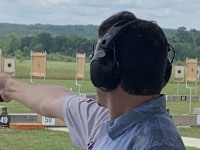
SingleActionAndrew- Admin
- Posts : 674
Join date : 2019-11-19
Location : IL, USA
 Re: Calling the shots
Re: Calling the shots
That's an excellent question. I think that the answer is "sometimes." But they don't really know until it happens. In other words, I know that if I am focused on the sights I will see the muzzle or the brass ejecting. I think that they tend to be focused somewhere between the target and the sights or what I call "no mans land."

jmdavis- Posts : 1409
Join date : 2012-03-23
Location : Virginia
 Re: Calling the shots
Re: Calling the shots
Sometimes, it’s best to celebrate one’s successes(even partial onesj and walk away from one’s failures…..
That may sound harsh but it’s reality, the light bulb comes on or it doesn’t….I would just let it go and let the success of the other shooters show the way….maybe the bulb clicks on then, but then again maybe not. My two cents from my own experience.
That may sound harsh but it’s reality, the light bulb comes on or it doesn’t….I would just let it go and let the success of the other shooters show the way….maybe the bulb clicks on then, but then again maybe not. My two cents from my own experience.

TonyH- Posts : 802
Join date : 2018-08-06
Location : Utah's Dixie
 Re: Calling the shots
Re: Calling the shots
Calling shots is a “learned” skill. It requires lots of range time and lots of rounds down range. You are training yourself to see what a good shot looks like and feels like. It’s very common to hear a lower classified shooter say “that shot looked perfect but wasn’t”. They haven’t develop the feel part of good shot execution. Be patient and keep working at it. It’s kinda like learning to really watch the front sight. A light bulb eventually comes on!
Jon
Jon
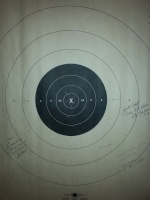
Jon Eulette- Posts : 4399
Join date : 2013-04-15
Location : Southern Kalifornia
Kirk A and Steve B like this post
 Re: Calling the shots
Re: Calling the shots
To me calling the shot is like recording a video, then playing it back immediately after the shot and look for where the dot was (or front-rear sight alignment) just before recoil took it away. It is far easier using a dot than open sights.
Calling shots can be practiced. I lay a target on the bench and have several coins or brass. Take a shot and immediately place a coin where I think the shot landed on the bench target. Then look through the scope and see where it actually lands. This works great with a 22 on a range with poor lighting so you can't cheat, but can be done by looking away or closing your eyes after the shot, but those are not good habits to practice too much.
If you really want to be put on the spot, have a partner with a spotting scope. Take the shot, then tell your partner your call and have them look through the scope and tell you how well you did.
Calling shots can be practiced. I lay a target on the bench and have several coins or brass. Take a shot and immediately place a coin where I think the shot landed on the bench target. Then look through the scope and see where it actually lands. This works great with a 22 on a range with poor lighting so you can't cheat, but can be done by looking away or closing your eyes after the shot, but those are not good habits to practice too much.
If you really want to be put on the spot, have a partner with a spotting scope. Take the shot, then tell your partner your call and have them look through the scope and tell you how well you did.
Jon Eulette likes this post
 Re: Calling the shots
Re: Calling the shots
I read the first paragraph and immediately thought: more dryfire. Then I read the last paragraph and you answered your own question.
I found that dryfire is easy to cheat at and just go through the motions and then tell your coach "yep, I dryfire every night". But why are things not getting better on target? Easy to "cheat".
Make a deal with the guy that won't dryfire that he only has to dryfire 5 shots but they have to be PERFECT shots and then he can stop. That might take him 30 minutes at first if he's not cheating but he has a simple, achievable goal. 5 "shots" BFD right? I found once I did this 5 shot routine regularly my shot calls improved dramatically and groups reduced dramatically. I didn't avoid dryfire because it could take only a few minutes if I committed to my process. Plus I dryfired more because I knew I could 5 so why not 10 PERFECT shots. It does test one's commitment because they can still cheat and call crap "good". Ask him how can you shoot tens at 50 if you can't execute a perfect shot in his dryfire "happy space?" Commitment to perfect dryfire is the only way to improve.
A friend of mine was a Quantico Team guy in the early 90's and I asked him to put on a clinic for some San Diego area shooters around 2003. He said no problem. One of the big things he did was line all twelve of us up on the 50 yard line and shoot one shot at a time, one person at a time. No spotting scopes. Just like Steve said. One shot, make the call. We did about 5 shots and at first most everyone was way off. By the fifth shot most had improved dramatically and some were shooting inside their call. The group dynamic is significant and once a person sees someone else make a perfect call they know its achievable. That's partly why coordinated teams reap greater gains than practicing alone.
I found that dryfire is easy to cheat at and just go through the motions and then tell your coach "yep, I dryfire every night". But why are things not getting better on target? Easy to "cheat".
Make a deal with the guy that won't dryfire that he only has to dryfire 5 shots but they have to be PERFECT shots and then he can stop. That might take him 30 minutes at first if he's not cheating but he has a simple, achievable goal. 5 "shots" BFD right? I found once I did this 5 shot routine regularly my shot calls improved dramatically and groups reduced dramatically. I didn't avoid dryfire because it could take only a few minutes if I committed to my process. Plus I dryfired more because I knew I could 5 so why not 10 PERFECT shots. It does test one's commitment because they can still cheat and call crap "good". Ask him how can you shoot tens at 50 if you can't execute a perfect shot in his dryfire "happy space?" Commitment to perfect dryfire is the only way to improve.
A friend of mine was a Quantico Team guy in the early 90's and I asked him to put on a clinic for some San Diego area shooters around 2003. He said no problem. One of the big things he did was line all twelve of us up on the 50 yard line and shoot one shot at a time, one person at a time. No spotting scopes. Just like Steve said. One shot, make the call. We did about 5 shots and at first most everyone was way off. By the fifth shot most had improved dramatically and some were shooting inside their call. The group dynamic is significant and once a person sees someone else make a perfect call they know its achievable. That's partly why coordinated teams reap greater gains than practicing alone.
robert84010- Posts : 834
Join date : 2011-09-21
chopper likes this post
 Re: Calling the shots
Re: Calling the shots
Thanks guys, the call your shots on a witness target before checking them is something I have done for rifle but it never crossed my mind as a teaching tool in this case.
I was lucky to have a couple of 2600 shooters to help me early on. Sadly both are gone now, but sometimes something that they told me comes to mind at exactly the right time. They said dryfire, I dryfire. They said focus on the front sight and you will see the muzzle flash and sure enough, I did. Maybe learning to call my shots with the rifle made it easier. At least I knew what the goal was.
I was lucky to have a couple of 2600 shooters to help me early on. Sadly both are gone now, but sometimes something that they told me comes to mind at exactly the right time. They said dryfire, I dryfire. They said focus on the front sight and you will see the muzzle flash and sure enough, I did. Maybe learning to call my shots with the rifle made it easier. At least I knew what the goal was.

jmdavis- Posts : 1409
Join date : 2012-03-23
Location : Virginia
 Re: Calling the shots
Re: Calling the shots
Break open a roll of nickels on the shooting bench.
"Each shot you call within 0.5" of where it hit, you get a nickel. Shoot until you have enough money for lunch. Until then, I guess you'll be hungry."
Guess why I'm not the US coach.
"Each shot you call within 0.5" of where it hit, you get a nickel. Shoot until you have enough money for lunch. Until then, I guess you'll be hungry."
Guess why I'm not the US coach.
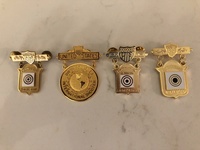
john bickar- Posts : 2279
Join date : 2011-07-09
Age : 100
Location : Menlo Park, CA
lakemurrayman likes this post
 Re: Calling the shots
Re: Calling the shots
You ate the last one out of all his money a nickle at a time?

Wobbley- Admin
- Posts : 4803
Join date : 2015-02-12
john bickar likes this post
 Re: Calling the shots
Re: Calling the shots
I was hungry.

john bickar- Posts : 2279
Join date : 2011-07-09
Age : 100
Location : Menlo Park, CA
 Re: Calling the shots
Re: Calling the shots
Actually, the last US coach was a "her".

john bickar- Posts : 2279
Join date : 2011-07-09
Age : 100
Location : Menlo Park, CA
 Re: Calling the shots
Re: Calling the shots
SingleActionAndrew wrote:Just a thought: do they see their muzzle blast? Can't call the shot if their eyes are closed or aren't present.
I'm not sure a person can see the brass fly when they are looking down at the target while using a dot. Have you? Maybe i'm missing something.
I only remember seeing the powder flash while using irons. I'm sure the dot is in the way.
These are both valid indicators. Another reason to learn using irons.
just saying...
robert84010- Posts : 834
Join date : 2011-09-21
 Re: Calling the shots
Re: Calling the shots
Ask them 'When the hammer fell, what did you see?' This should work with dry and live fire.
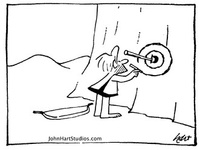
Jack H- Posts : 2698
Join date : 2011-06-10
Age : 75
Location : Oregon
 Re: Calling the shots
Re: Calling the shots
The best way I know (worked for me when I was young, still re-learning) - advise to congratulate themselves on right call more than on a good shot. Treat rightly called 6 as a very good shot. Treat 10 called as 8 as a bad shot, analyze why you were wrong.
UnGe- Posts : 83
Join date : 2021-02-22
Location : WA
 Re: Calling the shots
Re: Calling the shots
It is also very important that your pistol is zeroed. It is really hard to imagine trying to learn if you don't trust your call. that being said. If you trust your call you can adjust your sights to match.
true story . In Springfield I often shoot position 13. Right in front of Roddy calling the match. Starting the 45 match I shot 2x's. Roddy scoped them then looked at me cranking on my sights . I called them 12oclock 9s. looking back It was probably still on 25yd zero . Trust is a must. The next shot was not an X. But It was on call.
true story . In Springfield I often shoot position 13. Right in front of Roddy calling the match. Starting the 45 match I shot 2x's. Roddy scoped them then looked at me cranking on my sights . I called them 12oclock 9s. looking back It was probably still on 25yd zero . Trust is a must. The next shot was not an X. But It was on call.

LenV- Posts : 4768
Join date : 2014-01-24
Age : 74
Location : Oregon
 Re: Calling the shots
Re: Calling the shots
Mike,
I’m not a pistol coach at all, but I did OK as a rifle coach way back when…
I agree with some of the others that you answered your own question. The guy who dry fires pays attention to his front sight; those who don’t, don’t. I used a simple artifice when I coached rifle. “Keep aiming and squeezing all the way through recoil”. Recoil will disrupt the sight picture, of course, but the shooter will remember what he saw the instant the shot broke because that’s what he’s paying attention to. Since he’s continuing to squeeze, his shooting hand won’t have time to do anything stupid. This is kind of the same as telling someone to follow through, but it translates easily from a verbal idea to a non-verbal skill and it forces the shooter to do something positive. If you’re truly aiming and squeezing you can’t jerk, flinch, anticipate, close your eyes, or head for the spotting scope. If you incorporate this into your dry fire routine until it becomes a subconscious part of your technique a lot of good things accrue. And it’s easy to establish if you dry fire.
You might be able to convince those who don’t dry fire to try it by asking the question “How do you know what happens when the hammer falls if it’s always masked by recoil?”. If they say it doesn’t matter ask them if they see their brass.
Bob
I’m not a pistol coach at all, but I did OK as a rifle coach way back when…
I agree with some of the others that you answered your own question. The guy who dry fires pays attention to his front sight; those who don’t, don’t. I used a simple artifice when I coached rifle. “Keep aiming and squeezing all the way through recoil”. Recoil will disrupt the sight picture, of course, but the shooter will remember what he saw the instant the shot broke because that’s what he’s paying attention to. Since he’s continuing to squeeze, his shooting hand won’t have time to do anything stupid. This is kind of the same as telling someone to follow through, but it translates easily from a verbal idea to a non-verbal skill and it forces the shooter to do something positive. If you’re truly aiming and squeezing you can’t jerk, flinch, anticipate, close your eyes, or head for the spotting scope. If you incorporate this into your dry fire routine until it becomes a subconscious part of your technique a lot of good things accrue. And it’s easy to establish if you dry fire.
You might be able to convince those who don’t dry fire to try it by asking the question “How do you know what happens when the hammer falls if it’s always masked by recoil?”. If they say it doesn’t matter ask them if they see their brass.
Bob
crmath- Posts : 29
Join date : 2020-04-24
Age : 74
Location : Central PA
dieselguy624 likes this post
 Re: Calling the shots
Re: Calling the shots
Greetings,
Way back in the late 70's I started competitive shooting.
I was fortunate to have a retired Air Force shooter take me under his wing. Robert V. Coghe, RIP.
He would have me shoot one round and bark. "Where did the shot go?"
Repeat the above many times. Factor in a few "Bad Call, You are not watching your sights!!!"
All of the training was done at 25 yards with the goal of shooting all X's.
One training aid was to paint a white dot on the rear of the front sight. "Can you see the dot?" was barked into my ear.
Every Saturday morning this exercise took place. Once I was able to shoot ten X's slow fire at 25 yards was I allowed to move my target to 50 yards.
I miss the "good old days..."
Cheers,
Dave
Way back in the late 70's I started competitive shooting.
I was fortunate to have a retired Air Force shooter take me under his wing. Robert V. Coghe, RIP.
He would have me shoot one round and bark. "Where did the shot go?"
Repeat the above many times. Factor in a few "Bad Call, You are not watching your sights!!!"
All of the training was done at 25 yards with the goal of shooting all X's.
One training aid was to paint a white dot on the rear of the front sight. "Can you see the dot?" was barked into my ear.
Every Saturday morning this exercise took place. Once I was able to shoot ten X's slow fire at 25 yards was I allowed to move my target to 50 yards.
I miss the "good old days..."
Cheers,
Dave
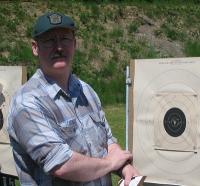
fc60- Posts : 1458
Join date : 2011-06-11
Location : South Prairie, WA 98385
dieselguy624 and lyman1903 like this post
 Similar topics
Similar topics» Calling shots
» Calling shots
» Calling my shots
» Having trouble calling shots?
» Calling shots. Sights OK. Arm not....
» Calling shots
» Calling my shots
» Having trouble calling shots?
» Calling shots. Sights OK. Arm not....
Page 1 of 1
Permissions in this forum:
You cannot reply to topics in this forum